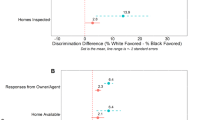Abstract
The persistence of wage discrimination raises a number of questions, including the following: if majority-owned firms continue to discriminate against minority workers, is it possible for the minority workers to escape that discrimination by forming a firm? Non-discriminating minority firms could then provide a refuge for other minority workers. In Becker’s classic treatment of discrimination by firms he posits a variation of this idea. He suggests that if the number of jobs at non-discriminating firms is greater than the number of minority workers, then these minority workers will all find their way to and be employed by the non-discriminating firms. In this paper I employ simulations to examine the extent to which minority workers can successfully find employment at non-discriminating minority firms in the presence of labor market frictions. These simulations also demonstrate the importance of access to capital for minority entrepreneurs.
Similar content being viewed by others
References
Aigner, D., & Cain, G. (1977). Statistical theories of discrimination in labor markets. Industrial and Labor relations review, 30(2), 175–187.
Altonji, J. G., & Pierret, C. R. (1997). Employer learning and statistical discrimination (No. w6279). National Bureau of Economic Research.
Axtell, R. (2013) Endogenous firms and their dynamics. Working Paper, Santa Fe Institute.
Becker, G. S. (1957). The economics of discrimination. Chicago: University of Chicago Press.
Black, D. A. (1995). Discrimination in an equilibrium search model. Journal of Labor Economics, 13, 309–334.
Borjas, G. J., & Bronars, S. G. (1989). Consumer discrimination and self-employment. Journal of Political Economy, 97, 581–605.
Bowlus, A. J., & Eckstein, Z. (2002). Discrimination and skill differences in an equilibrium search model. International Economic Review, 43(4), 1309–1345.
Coate, S., & Tennyson, S. (1992). Labor market discrimination, imperfect information and self employment. Oxford Economic Papers, 44(2), 272–288.
Cowan, T., & Feder, J. (2008). The pigford case: USDA settlement of a discrimination suit by black farmers. Congressional Research Service, Library of Congress
Eckstein, Z., & Wolpin, K. (1995). Duration to first job and the return to schooling: Estimates from a search-matching model. The Review of Economic Studies, 62(2), 263–286.
Eckstein, Z., & Wolpin, K. (1999). Estimating the effect of racial discrimination on first job wage offers. Review of Economics and Statistics, 81(3), 384–392.
Fagiolo, G., Dosi, G., & Gabriele, R. (2004). Matching, bargaining, and wage setting in an evolutionary model of labor market and output dynamics. Advances in Complex Systems, 7(02), 157–186.
Flabbi, L. (2010). Gender discrimination estimation in a search model with matching and bargaining. International Economic Review, 50(3), 745–783.
Hammarstedt, M. (2006). The predicted earnings differential and immigrant self-employment in Sweden. Applied Economics, 38(6), 619–630.
Leung, D. (2006). The male/female earnings gap and female self-employment. The Journal of Socio-Economics, 35(5), 759–779.
Lundberg, S., & Startz, R. (1983). Private discrimination and social intervention in competitive labor market. The American Economic Review, 73(3), 340–347.
Moore, R. L. (1983). Employer discrimination: Evidence from self-employed workers. The Review of Economics and Statistics, 65, 496–501.
Munnell, A. H., Tootell, G. M., Browne, L. E., & McEneaney, J. (1996). Mortgage lending in Boston: Interpreting HMDA data. The American Economic Review, 86(1), 25–53.
Richiardi, M. (2006). Toward a non-equilibrium unemployment theory. Computational Economics, 28, 421–446.
Rosén, Å. (1997). An equilibrium search-matching model of discrimination. European Economic Review, 41(8), 1589–1613.
Tesfatsion, L. (1997). A trade network game with endogenous partner selection. In H. M. Amman, B. Rustem, & A. B. Whinston (Eds.), Computational approaches to economic problems (pp. 249–269). Dordrecht: Kluwer Academic Publishers.
Williams, D. R. (2012). Gender discrimination and self-employment dynamics in Europe. The Journal of Socio-Economics, 41(2), 153–158.
Author information
Authors and Affiliations
Corresponding author
Rights and permissions
About this article
Cite this article
Fain, J. Can Minorities Escape Wage Discrimination by Forming Firms?. Comput Econ 50, 425–445 (2017). https://doi.org/10.1007/s10614-016-9592-1
Accepted:
Published:
Issue Date:
DOI: https://doi.org/10.1007/s10614-016-9592-1




